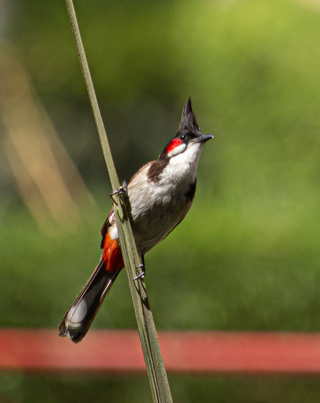
The red-whiskered bulbul, or crested bulbul, is a passerine bird native to Asia. It is a member of the bulbul family. It is a resident frugivore found mainly in tropical Asia. It has been introduced in many tropical areas of the world where populations have established themselves. It has a loud three or four note call, feeds on fruits and small insects and perches conspicuously on trees. It is common in hill forests and urban gardens.
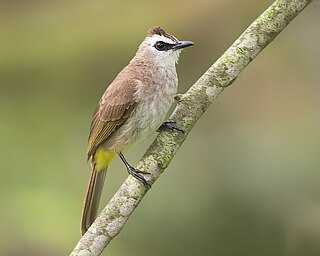
The yellow-vented bulbul, or eastern yellow-vented bulbul, is a member of the bulbul family of passerine birds. It is a resident breeder in southeastern Asia from Indochina to the Philippines. It is found in a wide variety of open habitats but not the deep forest. It is one of the most common birds in cultivated areas. They appear to be nomadic and roam from place to place regularly.
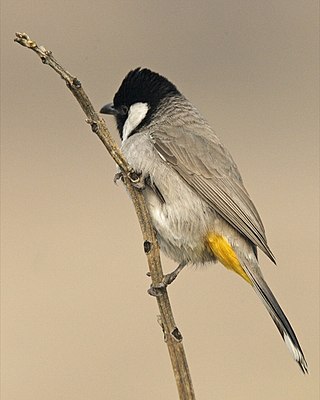
The white-eared bulbul is a member of the bulbul family. It is found in south-western Asia from India to the Arabian peninsula.

The white-throated bulbul is a species of songbird in the bulbul family, Pycnonotidae. It is found in south-eastern Asia from the eastern Himalayas to Myanmar and western Thailand. Its natural habitat is subtropical or tropical moist lowland forests.

The ochraceous bulbul is a species of songbird in the bulbul family, Pycnonotidae. It is found from Southeast Asia to Sumatra. It is usually found in the mid-storey of broad-leaved evergreen and rainforests up to 1500 metres elevation.

The puff-throated bulbul is a songbird in the bulbul family, Pycnonotidae. The species was first described by Robert Swinhoe in 1870. It is found in Southeast Asia. Its natural habitat is subtropical or tropical moist lowland forests.

The ashy bulbul is a species of songbird in the bulbul family, Pycnonotidae. It is found on the Indian subcontinent and in Southeast Asia. Its natural habitats are subtropical or tropical moist lowland forest and subtropical or tropical moist montane forest.

The mountain bulbul is a songbird species in the bulbul family, Pycnonotidae. It is often placed in Hypsipetes, but seems to be closer to the type species of the genus Ixos, the Sunda bulbul. It is found in Southeast Asia and is not considered a threatened species by the IUCN. It is named after British East India Company Surgeon John McClelland.
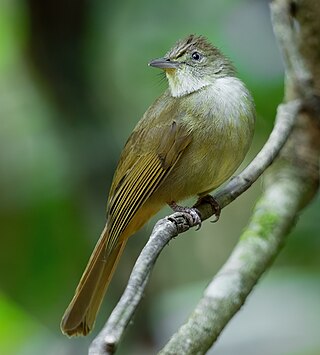
The grey-eyed bulbul is a species of songbird in the bulbul family, Pycnonotidae. It is found in Southeast Asia in its natural habitat of subtropical or tropical moist lowland forests.
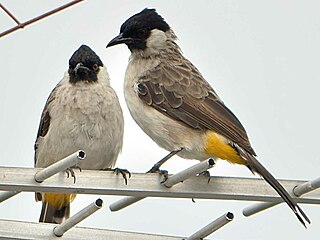
The sooty-headed bulbul is a species of songbird in the Bulbul family, Pycnonotidae. It is found in south-eastern Asia. Its natural habitat is subtropical or tropical moist lowland forests.
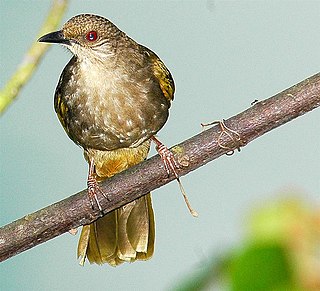
Pycnonotus is a genus of frugivorous passerine birds in the bulbul family Pycnonotidae.

The stripe-throated bulbul, or streak-throated bulbul, is a species of songbird in the bulbul family of passerine birds. It is found in south-eastern Asia where its natural habitats are tropical moist lowland forest and tropical moist montane forest. It is a common species and the International Union for Conservation of Nature has assessed it as being of "least concern".

The flavescent bulbul is a species of songbird in the bulbul family of passerine birds. Its name comes from flavescent, a yellowish colour. It is found in south-eastern Asia.

The striated bulbul is a species of songbird in the bulbul family, Pycnonotidae. It is the only species placed in the genus Alcurus .

The brown-breasted bulbul is a songbird in the family Pycnonotidae. The species was first described by John Anderson in 1869.

The Bornean bulbul is a member of the bulbul family of passerine birds. It is endemic to the island of Borneo.

The ruby-throated bulbul, or yellow bulbul, also known as flame throated bulbul is a member of the bulbul family of passerine birds. It is found on Sumatra, Java, and Bali.

The flame-throated bulbul is a member of the bulbul family of passerine birds and the state bird of Goa. It is found only in the forests of the Western Ghats in southern India. Formerly included as a subspecies of Pycnonotus flaviventris it has since been elevated to the status of a full species. They are olive-backed with yellow undersides, a triangular orange-red throat and a white iris that stands out against the contrasting black head. They are usually seen foraging in groups in the forest canopy for berries and small insects. They have a call often with two or three tinkling notes that can sound similar to those produced by the red-whiskered bulbul. The species has been referred to in the past by names such as ruby-throated bulbul and black-headed bulbul, but these are ambiguous and could apply to other species such as Rubigula flaviventris and R. dispar.

The black-capped bulbul, or black-headed yellow bulbul, is a member of the bulbul family of passerine birds. It is endemic to Sri Lanka.

The dark-capped bulbul is a member of the bulbul family of passerine birds. It is found in central, eastern and south-eastern Africa.
























